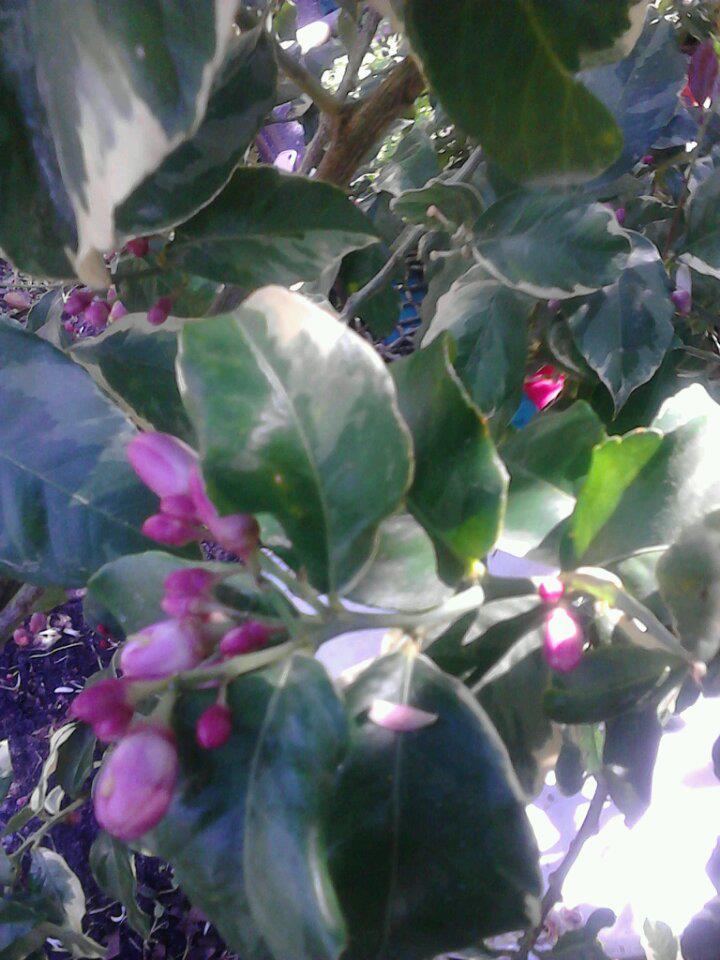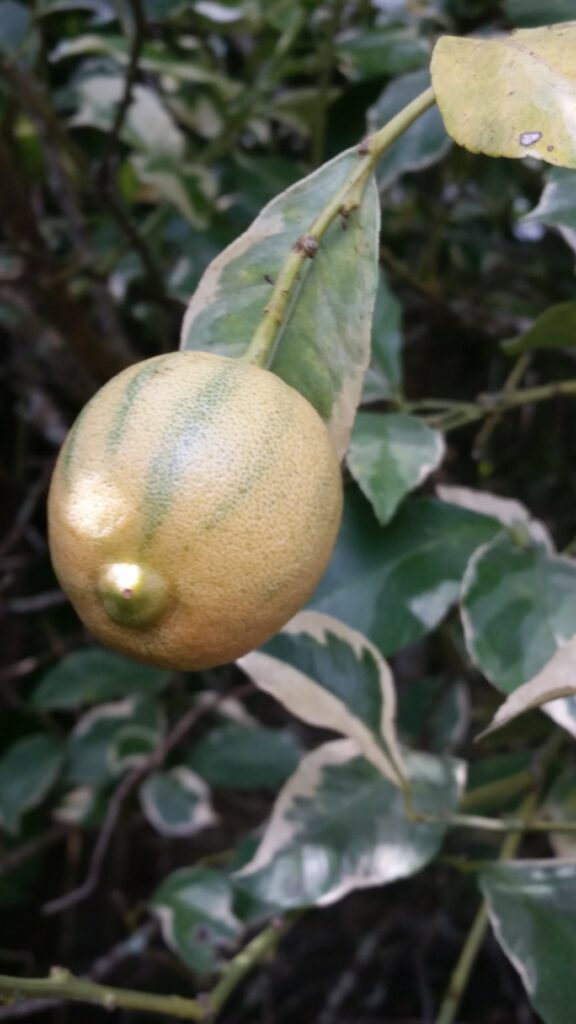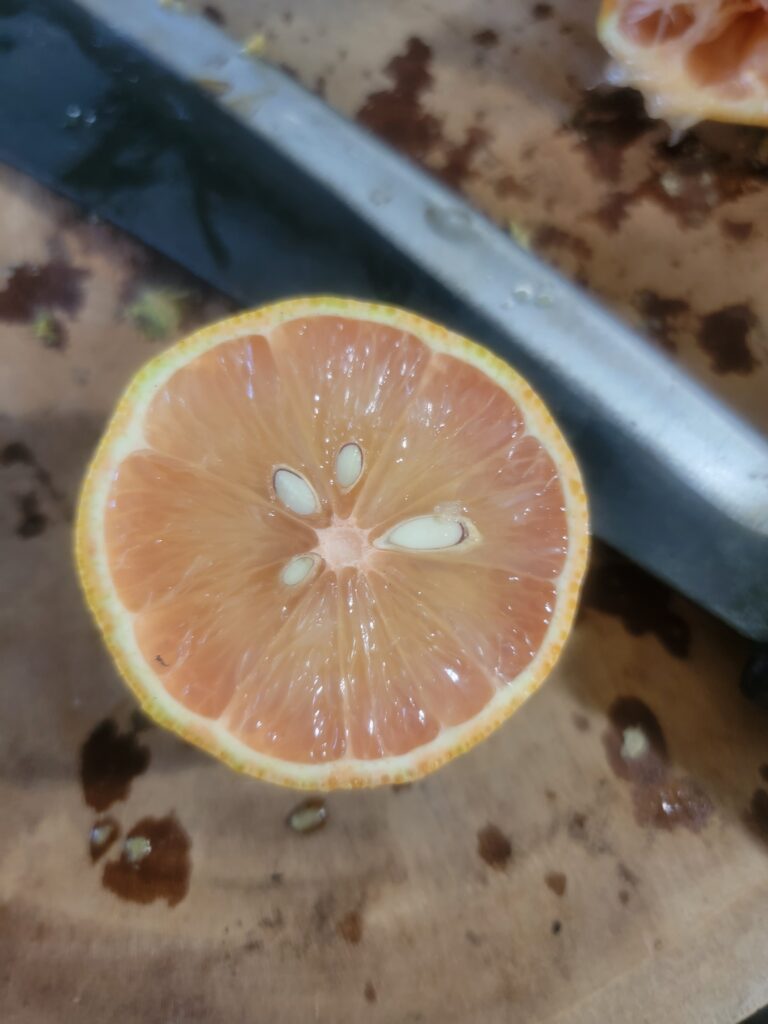Growing Variegated Pink Lemons in Northeast Florida Landscapes ( Citrus x limon Ponderosa )
Origin of the Variegated Pink Lemon Tree For Northeast Florida :

Despite the fact that they were discovered as a sport of the Eureka lemon in California all the way back to 1931 these gorgeous trees somehow remain a bit more of a rare specimen. Personally, it was one of the first lemons I added to my collection of fruit trees, not even yet knowing how delicious the pink lemon is, I just fell in love with the amazing variegated foliage!
The Eureka lemon was picked from among the seedlings planted of a Sicilian lemon tree planted in California in the mid 1800’s. It has few thorns, high acid fruit and is the main lemon grown in California. The small mature size of a Eureka lemon tree make it perfect for potted citrus and small scale yards.
Winter Temperature Tolerance For Variegated Pink Lemon Trees:
Lemons are the most cold sensitive of Citrus fruit but can be planted in our area of Northeast Florida in zones 9-11.
See Lemon Home for details on where to plant lemon trees in Northeast Florida gardens.
Sun Exposure for the Variegated Pink Lemon Tree in Northeast Florida:
Plant Variegated pink lemon trees where they will receive full sun in the Jacksonville and St. Augustine area landscapes.
Soil Preference for the Variegated Pink Lemon Tree:
It is no longer a recommended practice to amend the soil in the planting hole on Citrus trees in good soil according to the University of Florida’s Institute of Food and Agricultural Sciences. However, probably due to the simple fact that old habits die hard, one UFIFAS citrus publication cautions, if you are going to amend your soil be sure to use a 50-50 ratio. In other words, use equal parts soil amendment and native soil (that is the soil you dug out of the hole before placing the tree in it), and mix the amended soil together with the native soil before back filling the hole around the tree.
Planting and Mulching Tips For Variegated Pink Lemon Trees in the Jacksonville or St. Augustine area landscape:
NOTE: THIS IS IMPORTANT
-Be sure to plant into well draining soils, and keep the soil level of the dirt in the container above the soil level of the ground by 1-2 inches when you are finished planting. The soil that your tree was growing in should be slightly higher or level with the ground
– Never bury the top of the root system that the tree was growing in. The soil in the top of the pot should be exposed to the air after planting, not buried by soil in any way.
Caution: Do not build berms around Citrus to hold water, as is recommended for pretty much all other trees. Leave a 12 inch diameter area around Citrus tree trunks with no mulch, do not put mulch up to the trunk of the tree on Citrus Root rot can develop quickly and good drainage is essential to a healthy tree.
Remove the grass and weeds growing under the foliage of any Citrus tree in Northeast Florida about a foot beyond where the foliage stops. Don’t allow grass and weeds to regrow under your Florida Citrus.
When planting in areas with a high water table, consider planting your Citrus into a raised berm a few feet high and 6 or more ft wide. This will keep your Citrus roots up out of the water soaked ground during periods of heavy rain.
Wow, that was allot of ‘don’ts’! Here’s one last one. Don’t worry, it really isn’t as hard as it seems, once you get them going Citrus trees just keep on growing! Also, here is a ‘Do’ for you and its a good one…
- DO… put the leaves of any Oak trees you can find under and around the canopy of your Citrus trees. UFIFAS has now recommended this practice to help combat Citrus greening
Size of the Variegated Pink Lemon Tree When Mature:
The mature size on a Variegated Pink lemon tree is around 10 ft tall and 12 ft wide.
Pruning and Growth Habits of Variegated Pink Lemon Trees for the Northeast Florida Landscape:

Variegated Pink lemon trees are short and wide with sparse foliage and a spreading habit. .
Pruning may be needed on occasion to remove suckers that sprout up from the trunk, or to remove dead wood that can cause problems when left on the tree.
When purchasing trees from an S & J Nursery container less than a 30 gallon pot size, pruning may be needed to shape the young trees into a desirable framework, and light pruning each year to develop the lemon trees rounded or mushroom shaped canopy.
As the tree matures it should be shaped by selecting 3-5 main branches, well spaced along the trunk for fruiting production. Remove branches with narrow angles, and sub branches that are crossing or rubbing on other branches.
Pruning Tip for Citrus Trees: Light but frequent pruning has a tendency to relocate fruit from being produced mainly on branch tips to inside the canopy of the citrus tree. This can help increase the trees yield and keep the end heavy branches from breaking during overly productive years on some Citrus species.
Blooms and Fruit of Variegated Pink Lemon for Northeast Florida Landscape:
There may be nothing quite like a citrus tree in full bloom. The smell is magnificent! Mature citrus trees are said to be able to produce up to 100,000 blooms in a single year! They bloom mostly in early spring in Florida, but often do a smaller summer flowering around June that will produce a smaller second crop of fruits giving the selection the name “ever-bearing”.
Variegated Pink Lemon trees are self pollinating, so there is no need for a second tree to pollinate your lemon tree in order for it to produce fruit.

The fruit has a fantastic flavor with soft pink colored flesh that yields a normal yellow colored juice and has a vibrantly yellow and green stripe on the peel when young that fades as it ages and matures.
Water Requirements of the Variegated Pink Lemon in the Jacksonville and St. Augustine area Landscape:
Newly planted citrus trees require watering every other day for the first month and twice a week for the first few months, or in sandy soils when the top two inches of soil is dry to the touch. Take care to make sure that newly planted citrus trees receive water at least once a week for the first 2 years after being planted, skipping watering altogether once the local rain season is here.
Mature citrus trees need little to no supplemental irrigation and are more often damaged by over watering than under watering.
When citrus trees need supplemental irrigation, make sure to irrigate the soil only and not the trunk or foliage, this is best done by hand with a hose.
Fertilizing Your Variegated Pink Lemon Tree for Northeast Florida, Jacksonville and St. Augustine area Gardens:
Lemon trees tend to be a bit demanding on the fertilizing side of the equation.
A good quality fertilizer specifically formulated for citrus trees should be used. Fertilize in spring, again in summer and, skip the fall application in Northeast Florida, and then again in January. Spread your fertilizer out into the circle of non grass area under the Canopy of your citrus tree. Be sure to pay attention to the Citrus food label it should be a half pound to a lb of fertilizer for every inch of diameter on the trunk depending on the fertilizer you chose! It seems like a lot to use but it wont burn your tree. its what it needs!
Other Great Citrus Trees available at S & J Nursery for the Northeast Florida,
Jacksonville | St. Augustine Area Gardens
Bearss Lemon

